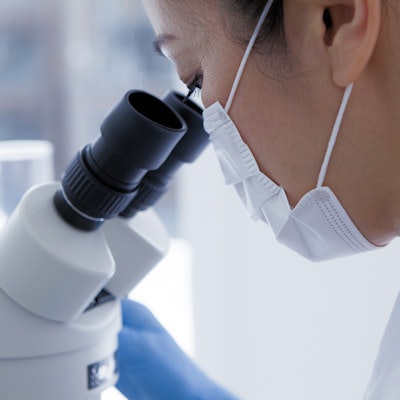
As clinical laboratories embrace genetic testing to improve their diagnosis of disease, many are turning to next-generation sequencing (NGS) to speed diagnosis.
Sequencing shows if a gene contains variants or mutations linked to an illness or a disorder. NGS offers a way to complement, or replace, many conventional laboratory tests, and it is finding applications in microbiome analysis, metagenomics, transcriptome profiling, infectious disease and oncology diagnosis, pathogen discovery, and public health surveillance, among other areas.
In clinical microbiology, NGS can identify unknown organisms, predict antimicrobial resistance, and analyze virulence genes.
But does every diagnostic laboratory have the volume to justify investing in the technology, where hardware and software costs can run several hundred thousands of dollars at a minimum? And this doesn't include the cost of hiring the right personnel who know how to perform the correct sequencing, and implementing the technology required to handle vast amounts of data.
On a positive note, Medicare is reimbursing NGS and in January 2020, the U.S. Centers for Medicare and Medicaid Services (CMS) expanded NGS coverage for breast and ovarian cancer.
NGS makes it possible to sequence many DNA or RNA strands simultaneously, instead of one at a time as with Sanger sequencing, which significantly increases throughput. A single test could pinpoint hundreds or thousands of genetic variants or disease-causing mutations that could help diagnose a medical condition or predict the risk of developing certain conditions. This quickens diagnosis and enables better-targeted treatments.
Basic NGS steps
NGS is a complex process. In the workflow, a sequencing library must be created from a sample, which is processed into short double-stranded fragments. Specific adapters are ligated to these fragments, forming a fragment library.
Before sequencing, the library is attached to a solid surface, and solid phase amplification increases the signal detected from each target during sequencing. All DNA in the library is sequenced simultaneously, and individual bases are read.
The NGS process creates large amounts of complex short DNA reads. These data and algorithms are so complex that bioinformatics professionals usually undertake NGS analysis. Primary analysis involves processing raw signals into digitized data. Secondary analysis involves, in part, filtering and aligning reads to a reference genome or groups of reads for unique genomes. Tertiary analysis entails interpreting results and generating meaningful information from the data.
An economic decision
"Nowadays, a laboratory's decision to jump into next-gen sequencing is probably going to be based on economics," said Dr. Christopher Corless, PhD, executive director of the Knight Diagnostic Laboratories at Oregon Health & Science University in Portland. The lab specializes in cancer testing and has an annual volume of approximately 27,000 tests.
 Dr. Christopher Corless, PhD, executive director of the Knight Diagnostic Laboratories at Oregon Health & Science University.
Dr. Christopher Corless, PhD, executive director of the Knight Diagnostic Laboratories at Oregon Health & Science University."Can they save their institution money or generate revenue by doing sequencing in-house as opposed to sending it to other labs like ours, or to one of the large commercial outfits? That's going to depend on a hospital's volume and needs," he said.
Corless noted that when his lab first started with NGS, the necessary bioinformatics was basically developed on the fly. Data storage and management of sequencing data also needed to be developed.
"Today, many solutions are commercially available and are provided as a package together with sequencing equipment, so it's not overly challenging for a lab to start up. There's a lot of assistance available," Corless said.
While there are two main players offering NGS platforms -- Illumina and Thermo Fisher -- there are several software and computer hardware solutions or packages that are available to labs, depending on which platform is selected, according to Corless.
"But just for the sequencing system, you're looking at about $350,000 and up. Top-of-the-line systems go up to about $1 million. And that does not include the computer hardware that you might need to support data storage and data management," Corless said. "There are smaller systems that you could use for more discrete projects, such as those involving infectious disease, but if you're doing cancer work, you're looking at $350,000 and up."
Corless explained that when sequencing, it's imperative to work on a group of samples to make it cost-effective to run them.
"If you have volume that is sufficient, then your costs are reasonable. But if you only sequence three samples a week, your costs are going to be exorbitant because you're wasting a lot of reagents," he said.
Corless also noted that this type of sequencing generally yields results in the seven- to 10-day time frame.
Quality metrics crucial
In addition, several challenges exist regarding managing, interpreting, and storing the data.
"There's a ton of work," Corless explained. "Every sequence run has many quality metrics that have to be looked at carefully. If the sequence quality is sufficient, then you have to determine which variations in the sequence are present, and how they differ from the reference genome."
"We sort out and report variants that are known mutations," he said. "Then the report has to provide additional information to the oncologist as to how the information should be acted on."
Proper personnel
The complexity of the technology necessitates that lab personnel have the proper skill sets. Labs have to figure out how they're going to manage the data, interpret and report the results, and provide support to the oncologists, he said.
"You have to have very good laboratory bench personnel who can perform the sequencing correctly. You need at least one PhD in the laboratory who is very familiar with sequence data, and how to interpret it," Corless continued. "You also need pathologists or geneticists who are able to create reports that provide meaningful context to the results ... reports that are helpful to the oncologist. You can't just report the mutations. You have to explain the implications for the patient."
Applications beckon
NGS is expected to play a greater role in medical microbiology laboratories, with applications in infection prevention, the investigation of outbreaks, the characterization and surveillance of pathogens, and the detection of resistance genes, among other uses, wrote John Rossen, PhD, of the department of medical microbiology and infection prevention at the University of Groningen in the Netherlands, and colleagues, in the Journal of Biotechnology.
Rossen and colleagues use NGS in their lab for outbreak management, molecular case finding, the characterization and surveillance of pathogens, the rapid identification of bacteria, taxonomy, and the metagenomics of clinical samples, as well as for determining the transmission of zoonotic microorganisms from animals to humans.
"The biggest challenge concerning the introduction of NGS in the clinical microbiology laboratory is the data analyses," Rossen and colleagues wrote in the paper. "Nonetheless, even with little knowledge of bioinformatics, it is possible to perform NGS data analyses for diagnostic purposes, using the numerous user-friendly software packages available. However, for more in-depth analysis, scientific knowledge is required on the genomic features and the biological background of the microorganism under investigation."
More research needed
The Groningen scientists indicate that additional research is needed to optimize NGS workflow, namely, to shorten the turnaround time for the library preparation and the runs on NGS platforms, and to further cut costs. Among their recommendations are more established typing schemes for pathogens, the establishment of cutoff values for these typing schemes, the development of reference databases containing genetic and metadata, and the creation of external quality controls for proficiency testing.
"Only then will patient guidance and infection control management at [the] local, (inter)regional and international level, as well as targeted antibiotic therapy using NGS data become a possibility, leading to personalized microbiology," the scientists stated.
In the future, NGS will play a greater role in advancing clinical diagnosis and precision medicine. NGS will benefit patients and improve health outcomes as the technology adds extensive knowledge to the clinical decision-making process.








